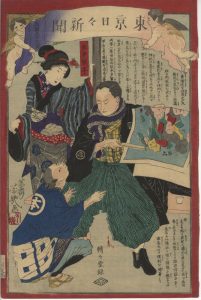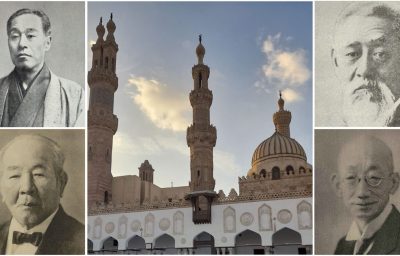COMMUNICATIONS
“Civilization and Enlightenment”: Filling Out the Picture
My earlier research could be said to belong to a fairly conventional strand of historical investigation that focused on a particular historical figure, as in the case of The Political Thought of Mori Arinori: A Study in Meiji Conservatism (2000), Mori Arinori, or, on more generalized aspects of the Meiji Restoration and its aftermath, as in my Meiji Restoration: Monarchism, Mass Communication and Conservative Revolution (2009).

Tokyo Nichinichi Shinbun, Illustrated Edition No. 566, 1874: From Fūzoku zue Database [Database of Folklore Illustrations]. Nichibunken Collection.
A more recent research project I have embarked on at Nichibunken, commencing in July of 2019, brings together strands of earlier research focusing on mass media and popular culture. The formal title of the research project is “Popular Culture and ‘Civilization and Enlightenment’: The Position and Role of Mass Media in the Turbulent Transition from Edo to Meiji.” In relation to the early Meiji period, Fukuzawa Yukichi promoted popularized notions of civilization and improvement through works such as An Encouragement of Learning and An Outline of a Theory of Civilization. The Meirokusha, the intellectual club set up by Mori Arinori in 1873, included such major contemporary scholars as Nishi Amane, Tsuda Mamichi, and Nakamura Masanao, as well as Fukuzawa Yukichi. It could be said that the Civilization and Enlightenment movement was largely orchestrated from the top down by established intellectuals and members of the new government who saw themselves in the paternalistic role of guiding an ignorant and unruly populace toward becoming an internationally respectable citizenry.

Tokyo Nichinichi Shinbun, Illustrated Edition No. 752, 1874: From Fūzoku zue Database [Database of Folklore Illustrations]. Nichibunken Collection.
Awareness of the merit of the “bottom up” perspective has been growing with increasing attention to the legacy of late Edo textual and visual cultural practices in early Meiji mass media. My own work within the current research project aims to expand understanding of practices relevant to gesaku by exploring the profound overlap between text, image, and oral performance in the early Meiji-era literary scene. The research to date has focused on the initiatives of early Meiji gesaku authors such as Jōno Saigiku and Takabatake Ransen who, in collaboration with nishiki-e artists such as Ochiai Yoshiiku and Tsukioka Yoshitoshi, spearheaded the development of “low-brow” newspapers with hiragana script alongside the Chinese characters and a distinctive genre of illustrated news, the nishiki-e shinbun. The picture that emerges is that, far from being mere incidental participants in the promotion of mass literacy and contemporary culture, these figures were instrumental in giving substance to the development of a public space where Civilization and Enlightenment could be interrogated and negotiated. I am deeply grateful for the generous support from Nichibunken that has enabled this research.
See also the introduction to Dr. Swale’s research on the Nichibunken Facebook page.




